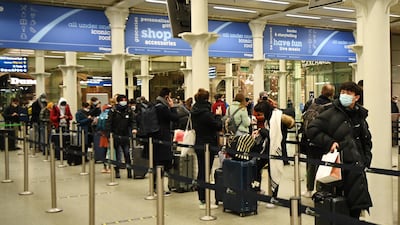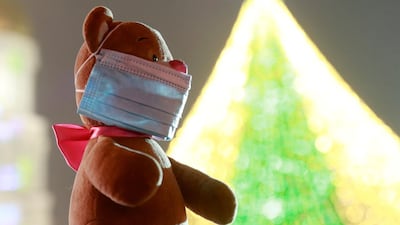In the western world, human beings spend 90 per cent of their time indoors. For years, scientists sounded the alarm that our disconnect from the outdoors is linked to numerous chronic health problems.
More recently, experts in various fields have begun studying why buildings, even those designed to minimise germs, are vectors for disease, not least Covid-19.
“There was a study of more than 7,300 cases in China, and guess how many people caught the disease outdoors?” said Luke Leung, director of the sustainable engineering studio of Skidmore Owings & Merrill. “Just two.”
Early testing after Black Lives Matter protests in Minnesota suggested that transmission of Sars-CoV-2 outside is rare, even when thousands of people gather, talking, yelling and chanting – at least when most of those people wear masks. Out of more than 13,000 protesters tested, only 1.8 per cent were positive. Other states showed similar results.

Mr Leung said a “misalignment with nature” in building design is partly to blame for our scourge of chronic diseases and the current pandemic. The relative lack of air flow and sunlight is an obvious issue; temperature, humidity and indoor air pollution all play a role. But there is another, less discussed factor: the microbiome of the built environment, which encompasses trillions of microbes including bacteria, fungi and viruses.
In 2015, researchers found that indoor air contains nearly equal concentrations of bacteria and viruses. Over time these many microbes have adapted to survive, and even thrive, everywhere from our pillowcases and toothbrushes to the more extreme climates of our dishwashers, shower heads, ovens and freezers.
Considering our perpetual emanations, it is easy to envision how the coronavirus might spread in a room. A single sneeze discharges about 30,000 microbe-filled droplets travelling at more than 300kph. A cough releases about 3,000 droplets, which reach speeds of 80kph. A simple exhale produces 50 to 5,000 droplets. We know that a person infected with influenza releases as many as 33 viral particles per minute just breathing and about 200 million per sneeze. Meanwhile, exposure to only a few hundred Sars-CoV-2 particles may be enough to cause infection.

Outdoors our invisible plumes almost always disperse quickly, which is a very good thing in the case of Covid-19 carriers.
“Any virus that is released into the air is rapidly diluted, moved by wind currents, and spread out across a seemingly infinite space,” said Linsey Marr, an expert in infectious disease transmission and professor of civil and environmental engineering at Virginia Tech.
“It’s almost like putting a drop of dye into the ocean vs putting it into a glass of water.”
Sunlight also inactivates viruses in as little as five minutes – eight minutes in the case of Sars-CoV-2. A study from the US Department of Homeland Security found the coronavirus can hang about indoors in the dark for hours.
Facing an invisible and potentially deadly virus, the understandable impulse has been to whip out some Clorox and go to battle. But indiscriminate bleach-bombing could backfire.
“It’s all theatre,” said Jack Gilbert, a professor and microbiome researcher at the University of California at San Diego. “You bleach the subway, the bleach dries up and becomes inactive. If just one person who has Covid-19 interacts with that surface, the four hours of cleaning have no effect.”
And because we now know Sars-CoV-2 is most often transmitted through the air, cleaning efforts seem even more futile.

A more serious risk is that attempts to sterilise our surroundings can kill off bacteria critical for human health – or, even worse, inadvertently promote the survival and evolution of more dangerous bugs, including antibiotic-resistant superbugs.
In hopes of zapping Sars-CoV-2 straight out of the air, some building managers are installing so-called bipolar ionisation units, even though they may not work against Covid and sometimes generate harmful gases, such as the lung irritant ozone. As for the antimicrobial cleaning agents and surface coatings being liberally applied throughout offices and other public spaces, we may be introducing large quantities of poorly understood, potentially poisonous chemicals into our everyday life – as well as speeding the evolution of disastrous superbugs.
“The more we use the same antimicrobials in different contexts, the more opportunity these microbes have to develop resistance,” said Erica Hartmann, an engineering professor at Northwestern University, who focuses on indoor microbiology and chemistry. “If they’re developing resistance to the antimicrobial itself, that’s not great, because then we’ve lost an important product in our cleaning arsenal.
"But if they also develop resistance to clinically relevant antibiotics, of which we have precious few, that’s an even bigger concern – and there’s evidence that both of those things happen.”
Our pandemic-era anti-germ crusade may not have a big effect on the already formed microbiomes of adults. But infants and young children, who need exposure to a wide variety of microbes to train their developing immune systems, could be more adversely affected.
"It's just speculation, but we could see a blip where this generation of kids has more immune-related conditions. Especially in places where people have had to stay quarantined indoors, where kids didn't get to go outside as much," Mr Knight said.

Mr Leung began thinking about the microbiology of buildings years before the pandemic.
Beyond using organic materials and maximising access to natural light and outdoor spaces, he said much can be done to make buildings healthier at the microbial level, including the use of filters designed to eliminate Sars-CoV-2 and other pathogens and contaminants, but he cautions against bipolar ionisation technology and says air should not be sterilised over long periods.
Whenever possible, Mr Leung suggests using ventilation systems that pump offices full of microbially diverse outdoor air.
“Sometimes we also open up buildings at night,” Mr Leung said, noting that the outdoor air is first measured for pollutants. “During the day people want air conditioning, but when they’re gone you can recharge the building with microbes from outside.”
Proper ventilation is particularly important in energy-efficient buildings. In addition to delivering fresh oxygen and eliminating the brain-numbing build-up of carbon dioxide, good airflow and filtration reduce exposure to a long list of mostly unregulated and unmonitored chemicals found indoors.
Another means of achieving healthier air is humidification. According to some calculations, viruses in dry air can survive six times as long as those in buildings with a relative humidity of about 40 per cent.

Of course, building interventions alone will not eliminate the risk of Sars-CoV-2 contagion, so it is best to keep social distancing and wearing masks.
In the meantime, scientists at universities and start-ups are racing to develop microbial sensors for air filters, building surfaces, wastewater, and even indoor air.
Once the pandemic hit, Mr Gilbert quickly redirected much of his research funding to studying Sars-CoV-2. He has one project together with Mr Knight’s lab to see how the virus travels through hospitals, where it most often takes up residence, and whether it piggybacks on nefarious bacteria, as the influenza virus often does.
He also has a second, more counterintuitive study under way in an undisclosed California hospital. Mr Gilbert is investigating whether adding harmless bacillus bacteria into medical facilities reduces the prevalence of pathogens, including multidrug-resistant bacteria and viruses.
“If you don’t have anything on a freshly disinfected surface, and you cough your virus-laden bacteria on to the table, it will survive there,” Mr Gilbert said. “But if there’s a high enough abundance of bacillus, then the bacillus will outcompete and exclude other pathogens that land on the surface.”
The idea of putting bacteria to work cleaning is not as far-fetched as it might sound. In the 1940s a Danish company called Novozymes started selling environmental microbes for decontaminating wastewater. Today, Novozymes is worth about $16 billion, and its microbes are key ingredients in dozens of homecare brands. The idea is to use an army of microbes that eat away at dirt, debris and organic matter, also degrading the stuff left in cracks and crevices.
Going a step further, scientists are studying whether salubrious environmental microbes can be introduced into urban homes to reduce the prevalence of inflammatory diseases.
Asked about the probiotic air enhancers, Mr Leung said: “It actually says a lot about human beings.
“We’ve created buildings so sterile that now we have to buy nature and spray it back in. That’s how silly we are.”
Perhaps the pandemic will serve as a wake-up call. “This is our chance to right our wrongs of the past 200 years,” he said, speaking of restoring our relationship with soils, plants and animals.
The climate crisis is compounding potential health risks as flooding, bushfires and man-made disasters destroy the natural world, exposing us to dangerous new diseases while annihilating the microbes we probably need to prevent widespread chronic illness (not to mention those we may need as medicines).
Already, Mr Leung said, urban air is often depleted of healthful natural bacteria. “In the wintertime, when the leaves are gone from trees, do you know what the main thing is you find in urban air?” he said. “Microbes from animal faeces.”
Still, the pandemic may be changing our perspective on indoor life – and even physically altering our microbiomes. Although some people are cleaning too much, eating more junk food and drinking more alcohol, prescriptions for antibiotics are markedly down from last year, according to the Centres for Disease Control and Prevention. One explanation is a decrease in non-Covid illnesses as a result of social distancing.

Although people are not mingling as much or sharing microbes – which can be beneficial when pathogens are not involved – those lucky enough to live where they are not required to hole up indoors are spending more time in nature.
“I see neighbours outside I didn’t even know existed, and they’re working in dirt that they’re pretending is a garden,” one microbiome expert said. As businesses allow employees to work from home, many are also abandoning urban life for greener settings.
But winter is upon us, and the pandemic is surging again as more people move indoors. If we do not adjust our lifestyle and start making our buildings healthier from a microbial standpoint now, Mr Leung said, we will be hit even harder.
“If you think this pandemic is bad, wait another 50 years when we have a much older population and much higher healthcare costs.”
In the not-so-distant future, he said, three interrelated factors will increasingly affect our well-being: climate change, chronic health problems, and more pandemics. “We’re going to have to design for that,” Mr Leung said. “And it’s going to be important to bring humans and nature together again.”












